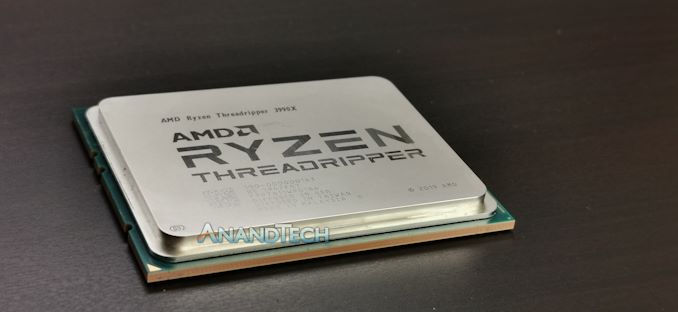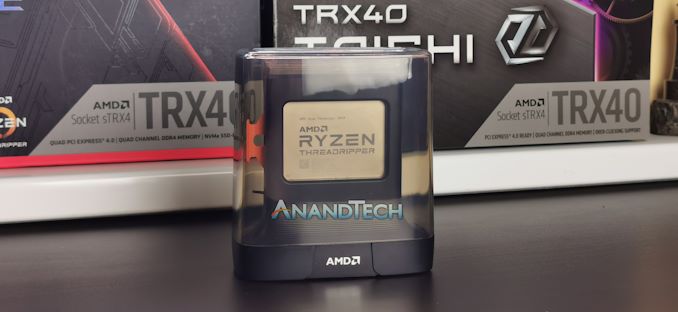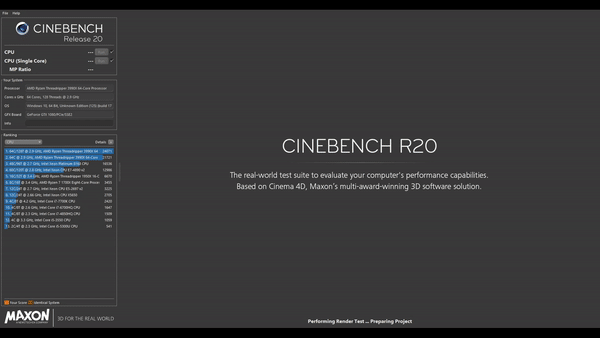The 64 Core Threadripper 3990X CPU Review: In The Midst Of Chaos, AMD Seeks Opportunity
by Dr. Ian Cutress & Gavin Bonshor on February 7, 2020 9:00 AM ESTConclusions
The art to building a good CPU is balance: you want something that is fast for individual streams of instructions and data, but also fast for multiple streams. You need something that is also power efficient, high yielding, and can be put together quite easily, with software out there already able to take advantage of what you have made.
“Opportunities multiply as they are seized.”
AMD has succeeded at a time when its competitor has struggled. As AMD launched its Zen 2 hardware across its Ryzen and EPYC product lines, built on TSMC’s 7nm, Dr. Lisa Su the CEO stated in interviews to AnandTech that:
‘We've executed our roadmap from the previous five years and we’re extending it into the next 5 years, all while assuming our competition will be competitive and even beating their public targets.’
At a time when Intel is struggling with its 10nm manufacturing process, AMD is targeting where Intel should have been if it had executed to time. The fact that Intel has suffered issues has benefited AMD, with its latest Ryzen and EPYC CPUs taking high praise. The follow on from these has been Threadripper, and the first two Zen 2 based Threadripper CPUs were quite good. I even used the word ‘bloodbath’ in the review, it was that impressive compared to what Intel had to offer.
Read our Initial Threadripper 3000 Series Review Here
With this third Threadripper 3000 processor, the 3990X, AMD is hoping to capitalize on its successes. The concept here is relatively simple: more of the same. Double the high-performance Zen 2 cores, at only slightly lower frequencies per core, for the same power – if a user has the right workload, then it’s the ideal processor.
And there-in likes the crux of this CPU; what is the right workload?
“Know yourself and you will win all battles”
One of the continual talking points about new CPUs is if the ecosystem is ready for them, especially with AMD pushing core counts ever higher. There’s no point having a million cores if everything is written for a few cores – not everyone runs a thousand copies of the same workload at the same time. Unfortunately this is what happened here with the 3990X. We’re in a situation where only a few software packages (that we tested) work great with the CPU, but it’s also the operating system that’s behind.
In our reviews, I prefer Windows for both comfort but also because a lot of the user base is on Windows. We typically use Windows 10 Pro, but because this CPU has 128 total threads, the regular version of Windows 10 Pro has issues – we had to move to Windows 10 Enterprise in order to see a difference. The alternative was to disable simultaneous multithreading, taking us back to one thread per core, which actually worked really well for a lot of tests, but also left some performance on the table. We suggest that 3990X users who typically have Windows 10 Pro do one of these two things: either disable SMT or use Win10 Pro for Workstations/Enterprise. This issue is down to how Windows tracks processor groups, an adage from multi-socket platforms, which shouldn’t apply here but because it’s hard coded into the OS when we have above 64 threads, it’s a pain.
Then there’s also the workload issue: we saw a number of tests, like Corona, Blender, and even NAMD, work great, which points to rendering and scientific compute benefiting from such a high core count processor. However other programs, such as 7-zip, LuxMark, Photoscan, and others did not see much (if any) of an improvement in performance compared to AMD’s own 32-core CPU.
I’ve heard a lot of silicon engineers say that adding cores helps, but adding frequency helps everything. The question then becomes whether you target workloads that can scale out (more cores) best, or whether scaling up (more frequency) is a better solution. We either end up with target CPUs for one or the other, or a combination CPU that tries to do both.
“[He] who wishes to fight must first count the cost”
In this review we evaluated two directions for AMD’s 64-core 3990X. The first was at the consumer/prosumer level, looking up to improve on their high-end desktop system. The second was at the enterprise level, looking down to see if that single 64-core CPU is actually worth it compared to a dual socket system. The conclusion might shock you. (It might not.)
For the first stage, the consumer/prosumer level, our conclusion is that the usefulness of the 3990X is limited. Aside from a few select instances (as mentioned, Corona, Blender, NAMD) the 32-core Threadripper for half the price performed on par or with margin. For this market, saving that $2000 between the 64-core and the 32-core can easily net another RTX 2080 Ti for GPU acceleration, and this would probably be the preferred option. Unless you run those specific tests (or ones like it), then go for the 32 core and spend the money elsewhere. Aside from the core count there is little to differentiate the two parts.
The second stage, the enterprise level, it becomes a no brainer to consolidate a dual socket system into a single AMD CPU – the initial outlay cost is substantially lower, and the long term power costs also come into play. This is what the enterprise likes to combine into ‘Total Cost of Ownership’, or TCO. The TCO and performance advantage of AMD here is plain to see in the benchmarks and the pricing. The situation gets a little muddier when we compare which AMD CPU to choose from: typically a server market wants RDIMM memory, which only comes from the EPYC processors. The difference between the 64-core EPYC 7702P and Threadripper 3990X is minor in terms of cost (under $500), and each CPU has its benefits: EPYC gets more PCIe lanes (128 vs 64) and more memory (8 channel RDIMM vs 4 channel UDIMM), while Threadripper gets better frequencies (2900/4300 vs 2000/3350) for a higher TDP (280W vs 200W). From a server perspective, if you need more IO or more memory, get the EPYC, otherwise Threadripper merits consideration.
“Do many calculations [to] lead to victory”
In the end, the situation for the 3990X is not as clear as it was with the 3970X. It’s a good chip, but it’s not the best chip for everything. I will tell you what it is good at though: ever seen Cinebench R20 complete in 16 seconds? Here you go:
A final thought. The AMD TR 3990X is amusingly priced at $3990. It’s a great marketing idea, and gets people talking. I’m proud to say that this price was my idea – AMD originally had it for something different. I don’t often influence change in the industry in such an obvious way, but this one was fun.
True story: the $3990 price tag on the 3990X is @IanCutress's doing. https://t.co/7CpuwubS6L
— Ryan Smith (@RyanSmithAT) January 6, 2020














279 Comments
View All Comments
dwade123 - Friday, February 7, 2020 - link
Fact is most x399 owners can't afford the new TR. Only ones defending these shady prices are lowly AM4 users who love the brand to death. Therefore, overpriced.Makaveli - Friday, February 7, 2020 - link
lol the same X399 owners that were buying $500 motherboards?Can't afford this?
Do you even know what you are talking about?
dwade123 - Friday, February 7, 2020 - link
Another AM4 pleb trying to present X399 users. Most sold TR models were under $1k. TR 3000 series starts at $1500. Try again at shilling.Korguz - Friday, February 7, 2020 - link
dwade123 , sounds like you are happy paying intel for its cpus before Zen was released :-) the tables have turned and amd has the better cpus, and all of a sudden, its wrong to charge prices like this ??deksman2 - Friday, February 7, 2020 - link
This threadripper isn't necessarily targeted at mainstream consumers but rather small businesses and studios for content creation (such as VFX companies) - just like now, VFX companies went for 32 cores TR (most 'regular consumers' went for maybe 16 core/32 threads if they could afford it).And on that note... just who from the regular consumer market is able to afford $20,000 Xeon to begin with?
The Xeon's are 5x more expensive in comparison.
So, on a cost scale alone, which CPU do you think would be more accessible?
The Xeon's or 3990x?
Also, as the article points out, the software is having problems with scaling beyond 32 cores properly to begin with.
So, most 'regular consumers' who can afford TR will likely go for the 32 core/64 thread version from the Zen 2 family (whereas VFX companies and small businesses would transition to 3990x once the software catches up).
MattZN - Friday, February 7, 2020 - link
Shady prices? Buying a system with similar capabilities just 2 years ago would have cost me $40,000.-Matt
Spunjji - Monday, February 10, 2020 - link
dwade123 is a Trump supporter; logic has no place in its world view.Korguz - Saturday, February 8, 2020 - link
ahh so how about those that were defending intels prices before zen came out ?? going by what you said, those cpus were also overpriced ??? fact is, most couldnt afford the prices intel was charging for its higher end chips... its funny how it seems when intel does something its ok.. but when amd does the same, its wrong....MattZN - Friday, February 7, 2020 - link
I think you are taking a rather expansive license with your use of "most". A better way to think about it is... who actually *needs* a system this big? I would guess that most of the people you are thinking about don't actually need a 3990X system for what they do. Not really.Not to mention that actually utilizing a 64-core/128-thread CPU fully would also require commensurate amounts of ram. For our needs, which are mostly bulk-compiles, 2GB/thread is required which is $1400 worth of memory just by itself (for 256GB worth of EUDIMMs).
$4000 + $1400 + storage... yah, it adds up. At that point nobody is going to be crying over a $500 motherboard.
-Matt
Spunjji - Monday, February 10, 2020 - link
Ableist slurs scattered amidst a nonsensical rant?Check.
Strawmanning anyone who disagrees?
Check.
Referring to anyone not buying top-of-the-range gear as a "peasant"?
Check.
Oh boy, it's a troll! Hooray! :|